Experimental Thermal Hazard Investigation of Pressure and EC/PC/EMC Mass Ratio on Electrolyte
Abstract
1. Introduction
2. Experimental Section
2.1. Samples and Materials
2.2. Experimental Platform
3. Results and Discussion
3.1. Combustion Process and Phenomena
3.2. Mass Loss Rate
3.3. Flame Centerline Temperature
3.4. Radiation Heat Flux
3.5. Heat Release Rate
- is the environmental pressure.
- is the barometric pressure when the altitude is 0 m.
- is the gas temperature in the exhaust duct, and the unit is K.
- is the pressure drop measured by orifice plate flowmeter, whose unit is Pa.
- A is the cross-sectional area (CSA) of exhaust duct, m2.
- Kt is the ratio of the average mass flow per unit area to mass flow per unit area in the center of the exhaust duct.
- Kp is the Reynolds number correction for the bi-directional probe suggested by Mc Caffrey and Heskestad.
- is a constant as 16.8 × 103 kJ/m3.
- is a constant as 1.105.
- is the ambient mole fraction of oxygen including water vapor.
- is the HRR from the burner.
4. Conclusions
- (1)
- The combustion process of LiBF4 in EC/PC/EMC electrolyte system with different mass ratio without external radiation could be divided into four stages: ignition, stable combustion stage, stable combustion with flame color change stage and extinguishing;
- (2)
- The flame centerline temperature increased with the decrease of ambient pressure, which was mainly due to the significant decline of flame radiation heat loss at low pressure;
- (3)
- The mass of oxygen per unit volume reduced with the decrease of pressure, resulting in a decline of the oxygen concentration between combustible vapor and air on the surface of electrolyte, resulting in lower oxygen diffusion rate under low pressure conditions, thus inhibiting the combustion rate of the electrolyte and the MLR fall, reducing the steps between MLR in the stable combustion stage and the stable combustion with flame color change stage, and prolonging the burning duration.
- (4)
- The pHRR and THR of the two electrolytes were almost the same, but those of Electrolyte 2 were slightly lower, and its conductivity was increased by 15.8% compared with Electrolyte 1. Thus, Electrolyte 2 has a relatively lower fire hazard and better comprehensive performance.
Author Contributions
Funding
Institutional Review Board Statement
Informed Consent Statement
Data Availability Statement
Acknowledgments
Conflicts of Interest
References
- Hou, P.; Wang, X.; Wang, D.; Song, D.; Shi, X.; Zhang, L.; Guo, J.; Zhang, J. A novel core-concentration gradient-shelled LiNi0.5Co0.2Mn0.3O2 as high-performance cathode for lithium-ion batteries. RSC Adv. 2014, 4, 15923–15929. [Google Scholar] [CrossRef]
- Eshetu, G.G.; Grugeon, S.; Gachot, G.; Mathiron, D.; Armand, M.; Laruelle, S. LiFSI vs. LiPF6 electrolytes in contact with lithiated graphite: Comparing thermal stabilities and identification of specific SEI-reinforcing additives. Electrochim. Acta 2013, 102, 133–141. [Google Scholar] [CrossRef]
- Madec, L.; Ma, L.; Nelson, K.J.; Petibon, R.; Sun, J.; Hill, I.G.; Dahn, J.R. The Effects of a Ternary Electrolyte Additive System on the Electrode/Electrolyte Interfaces in High Voltage Li-Ion Cells. J. Electrochem. Soc. 2016, 163, A1001–A1009. [Google Scholar] [CrossRef]
- Lagadec, M.F.; Zahn, R.; Wood, V. Characterization and performance evaluation of lithium-ion battery separators. Nat. Energy 2019, 4, 16–25. [Google Scholar] [CrossRef]
- Nelson, K.J.; Xia, J.; Dahn, J.R. Studies of the Effect of Varying Prop-1-ene-1,3-sultone Content in Lithium Ion Pouch Cells. J. Electrochem. Soc. 2014, 161, A1884–A1889. [Google Scholar] [CrossRef][Green Version]
- Zhang, B.; Liu, H. Theoretical prediction model and experimental investigation of detonation limits in combustible gaseous mixtures. Fuel 2019, 258, 116132. [Google Scholar] [CrossRef]
- Lee, C.W. A Novel Flame-Retardant Additive for Lithium Batteries. Electrochem. Solid-State Lett. 1999, 3, 63–65. [Google Scholar] [CrossRef]
- Kizilel, R.; Sabbah, R.; Selman, J.R.; Al-Hallaj, S. An alternative cooling system to enhance the safety of Li-ion battery packs. J. Power Sources 2009, 194, 1105–1112. [Google Scholar] [CrossRef]
- Zaghib, K.; Dubé, J.; Dallaire, A.; Galoustov, K.; Guerfi, A.; Ramanathan, M.; Benmayza, A.; Prakash, J.; Mauger, A.; Julien, C.M. Enhanced thermal safety and high power performance of carbon-coated LiFePO4 olivine cathode for Li-ion batteries. J. Power Sources 2012, 219, 36–44. [Google Scholar] [CrossRef]
- Seo, J.; Sankarasubramanian, S.; Kim, C.; Hovington, P.; Prakash, J.; Zaghib, K. Thermal characterization of Li/sulfur, Li/S–LiFePO4 and Li/S–LiV3O8 cells using Isothermal Micro-Calorimetry and Accelerating Rate Calorimetry. J. Power Sources 2015, 289, 1–7. [Google Scholar] [CrossRef]
- Chen, H.; Chen, J.; Zhang, W.; Xie, Q.; Che, Y.; Wang, H.; Xing, L.; Xu, K.; Li, W. Enhanced cycling stability of high-voltage lithium metal batteries with a trifunctional electrolyte additive. J. Mater. Chem. A 2020, 8, 22054–22064. [Google Scholar] [CrossRef]
- Li, M.; Wang, C.; Chen, Z.; Xu, K.; Lu, J. New Concepts in Electrolytes. Chem. Rev. 2020, 120, 6783–6819. [Google Scholar] [CrossRef] [PubMed]
- Borodin, O.; Self, J.; Persson, K.A.; Wang, C.; Xu, K. Uncharted Waters: Super-Concentrated Electrolytes. Joule 2020, 4, 69–100. [Google Scholar] [CrossRef]
- Jiang, L.; Liu, L.; Yue, J.; Zhang, Q.; Zhou, A.; Borodin, O.; Suo, L.; Li, H.; Chen, L.; Xu, K.; et al. High-Voltage Aqueous Na-Ion Battery Enabled by Inert-Cation-Assisted Water-in-Salt Electrolyte. Adv. Mater. 2019, 32, e1904427. [Google Scholar] [CrossRef] [PubMed]
- Eshetu, G.G.; Grugeon, S.; Laruelle, S.; Boyanov, S.; Lecocq, A.; Bertrand, J.; Marlair, G. In-depth safety-focused analysis of solvents used in electrolytes for large scale lithium ion batteries. Phys. Chem. Chem. Phys. PCCP 2013, 15, 9145–9155. [Google Scholar] [CrossRef]
- Fu, Y.; Lu, S.; Shi, L.; Cheng, X.; Zhang, H. Combustion Characteristics of Electrolyte Pool Fires for Lithium Ion Batteries. J. Electrochem. Soc. 2016, 163, A2022–A2028. [Google Scholar] [CrossRef]
- Ribière, P.; Grugeon, S.; Morcrette, M.; Boyanov, S.; Laruelle, S.; Marlair, G. Investigation on the fire-induced hazards of Li-ion battery cells by fire calorimetry. Energy Environ. Sci. 2012, 5, 5271–5280. [Google Scholar] [CrossRef]
- Gachot, G.; Grugeon, S.; Eshetu, G.G.; Mathiron, D.; Ribière, P.; Armand, M.; Laruelle, S. Thermal behaviour of the lithiated-graphite/electrolyte interface through GC/MS analysis. Electrochim. Acta 2012, 83, 402–409. [Google Scholar] [CrossRef]
- Armand, M.; Tarascon, J.M. Building better batteries. Nature 2008, 451, 652–657. [Google Scholar] [CrossRef]
- Li, Z.; He, Y.; Zhang, H.; Wang, J. Combustion characteristics of n-heptane and wood crib fires at different altitudes. Proc Combust. Inst. 2009, 32, 2481–2488. [Google Scholar] [CrossRef]
- Fu, Y. Studies on Combustion Characteristics of Typical Lithium lon Battery and Its Electrolyte as Well as Influence Mechanism of Air Transport Environment on Them; University of Science and Technology of China: Hefei, China, 2017. (In Chinese) [Google Scholar]
- Shinotake, A.; Koda, S.; Akita, K. An Experimental Study of Radiative Properties of Pool Fires of an Intermediate Scale. Combust. Sci. Technol. 2010, 43, 85–97. [Google Scholar] [CrossRef]
- Wieser, D.; Jauch, P.; Willi, U. The influence of high altitude on fire detector test fires. Fire Saf. J. 1997, 29, 195–204. [Google Scholar] [CrossRef]
- Bento, D.; Thomson, K.; Gulder, O. Soot formation and temperature field structure in laminar propane–air diffusion flames at elevated pressures. Combust. Flame 2006, 145, 765–778. [Google Scholar] [CrossRef]
- Zhang, W.; Chen, X.; Chen, Q.; Ding, C.; Liu, J.; Chen, M.; Wang, J. Combustion calorimetry of carbonate electrolytes used in lithium ion batteries. J. Fire Sci. 2014, 33, 22–36. [Google Scholar] [CrossRef]
- Niu, Y.; He, Y.; Hu, X.; Zhou, D.; Lin, C.; Yin, J.; Yao, W.; Wang, J. Experimental study of burning rates of cardboard box fires near sea level and at high altitude. Proc. Combust. Inst. 2013, 34, 2565–2573. [Google Scholar] [CrossRef]
- Chen, M.; Liu, J.; Lin, X.; Huang, Q.; Yuen, R.; Wang, J. Combustion characteristics of primary lithium battery at two altitudes. J. Therm. Anal. Calorim. 2016, 124, 865–870. [Google Scholar] [CrossRef]
- Liu, C.; Huang, Q.; Zheng, K.; Qin, J.; Zhou, D.; Wang, J. Impact of Lithium Salts on the Combustion Characteristics of Electrolyte under Diverse Pressures. Energies 2020, 13, 5373. [Google Scholar] [CrossRef]
- Chen, X.; Lu, S.; Li, C.; Zhang, J.; Liew, K.M. Experimental study on ignition and combustion characteristics of typical oils. Fire Mater. 2014, 38, 409–417. [Google Scholar] [CrossRef]
- Mulholland, G.; Henzel, V.; Babrauskas, V. The Effect Of Scale On Smoke Emission. Fire Saf. Sci. 1989, 2, 347–357. [Google Scholar] [CrossRef]
- Huang, Q.; Liu, C.; Wei, R.; Wang, J. Experimental study of polyethylene pyrolysis and combustion over HZSM-5, HUSY, and MCM-41. J. Hazard. Mater. 2017, 333, 10–22. [Google Scholar] [CrossRef] [PubMed]
- Qin, J.; Liu, C.; Huang, Q. Simulation on fire emergency evacuation in special subway station based on Pathfinder. Case Stud. Therm. Eng. 2020, 21, 100677. [Google Scholar] [CrossRef]
- Huang, Q.; Ma, L.; Liu, A.; Ma, X.; Li, J.; Wang, J.; Dahn, J.R. The reactivity of charged positive Li1-n[NixMnyCoz]O2 electrodes with electrolyte at elevated temperatures using accelerating rate calorimetry. J. Power Sources 2018, 390, 78–86. [Google Scholar] [CrossRef]
- Cao, W.; Liu, Y.; Chen, R.; Li, W.; Zhang, Y.; Xu, S.; Cao, X.; Huang, Q.; Tan, Y. Pressure release characteristics of premixed hydrogen-air mixtures in an explosion venting device with a duct. Int. J. Hydrogen Energy 2021, 46, 8810–8819. [Google Scholar] [CrossRef]
- Huang, Q.; Glazier, S.; Louli, A.; McArthur, M.; Liu, C.; Schrooten, J.; Dahn, J.R. Effects of graphite heat-treatment temperature on single-crystal Li[Ni5Mn3Co2]O2/graphite pouch cells. J. Electrochem. Soc. 2020, 167, 080543. [Google Scholar] [CrossRef]
- Liu, C.; Xu, D.; Weng, J.; Zhou, S.; Li, W.; Wan, Y.; Jiang, S.; Zhou, D.; Wang, J.; Huang, Q. Phase change materials application in battery thermal management system: A review. Materials 2020, 13, 4622. [Google Scholar] [CrossRef]
- Xu, K. Nonaqueous liquid electrolytes for lithium-based rechargeable batteries. Chem. Rev. 2004, 104, 4303–4417. [Google Scholar] [CrossRef] [PubMed]
- Wang, B.; Qu, Q.; Xia, Q.; Wu, Y.; Zhou, D.; Gu, X.; Ree, T. 2-Phenylimidazole as an additive to prevent the co-intercalation of propylene carbonate in organic electrolyte for lithium ion batteries. J. Power Sources 2009, 189, 757–760. [Google Scholar] [CrossRef]
- Smart, M.C.; Ratnakumar, B.V.; Behar, A.; Whitcanack, L.D.; Yu, J.S.; Alamgir, M. Gel polymer electrolyte lithium-ion cels with improved low temperature performance. J. Power Sources 2007, 165, 535–543. [Google Scholar] [CrossRef]
- Wang, B.; Zhang, H.; Yang, L.; Qu, Q.; Wu, Y.; Gan, C.; Zhou, D. Improving electrochemical performance of graphite carbon in PC-based electrolytes by using N-vinyl-2-pyrrolidone as an additie. Electrochem. Commun. 2008, 10, 1571–1574. [Google Scholar] [CrossRef]
- Zhang, B.; Chang, X.; Bai, C. End-wall ignition of methane-air mixtures under the effects of CO2/Ar/N2 fluidic jets. Fuel 2020, 270, 117485. [Google Scholar] [CrossRef]
- Wang, Q.; Ping, P.; Zhao, X.; Chu, G.; Sun, J.; Chen, C. Thermal runaway caused fire and explosion of lithium ion battery. J. Power Sources 2012, 208, 210–224. [Google Scholar] [CrossRef]
- Golubkov, A.W.; Fuchs, D.; Wagner, J.; Wiltsche, H.; Stangl, C.; Fauler, G.; Voitic, G.; Thaler, A.; Hacker, V. Thermal-runaway experiments on consumer Li-ion batteries with metal-oxide and olivin-type cathodes. RSC Adv. 2014, 4, 3633–3642. [Google Scholar] [CrossRef]
- Larsson, F.; Bertilsson, S.; Furlani, M.; Albinsson, I.; Mellander, B. Gas explosions and thermal runaways during external heating abuse of commercial lithium-ion graphite-LiCoO2 cells at different levels of ageing. J. Power Sources 2018, 373, 220–231. [Google Scholar] [CrossRef]
- Somandepalli, V.; Marr, K.; Horn, Q. Quantification of Combustion Hazards of Thermal Runaway Failures in Lithium-Ion Batteries. SAE Int. J. Altern. Powertrains 2014, 3, 98–104. [Google Scholar] [CrossRef]
- Fernandes, Y.; Bry, A.; de Persis, S. Identification and quantification of gases emitted during abuse tests by overcharge of a commercial Li-ion battery. J. Power Sources 2018, 389, 106–119. [Google Scholar] [CrossRef]
- Ping, P.; Wang, Q.; Huang, P.; Li, K.; Sun, J.; Kong, D.; Chen, C. Study of the fire behavior of high-energy lithium-ion batteries with full-scale burning test. J. Power Sources 2015, 285, 80–89. [Google Scholar] [CrossRef]
- Huang, P.; Wang, Q.; Li, K.; Ping, P.; Sun, J. The combustion behavior of large scale lithium titanate battery. Sci. Rep. 2015, 5, 7788. [Google Scholar] [CrossRef]
- De Ris, J.L.; Wu, P.K.; Heskestad, G. Radiation fire modeling. Proc. Combust. Inst. 2000, 28, 2751–2759. [Google Scholar] [CrossRef]
- Tu, R.; Lei, J.; Wang, Y.; Fang, J.; Zhang, Y. Small Scale Pool Fire Burning Rate Under Reduced Atmospheric Pressure Using Pressure Modeling. J. Combust. Sci. Technol. 2010, 5, 16. [Google Scholar] [CrossRef]
- Zhou, Z.; Wei, Y.; Li, H.; Yuen, R.; Jian, W. Experimental analysis of low air pressure influences on fire plumes. Int. J. Heat Mass Transf. 2014, 70, 578–585. [Google Scholar] [CrossRef]
- Quintiere, J.; Grove, B. A unified analysis for fire plumes. Symp. Int. Combust. 1998, 27, 2757–2766. [Google Scholar] [CrossRef]
- McCaffrey, B.J. Purely Buoyant Diffusion Flames: Some Experimental Results; National Bureau of Standards: Washington, DC, USA, 1979; pp. 10–25.
- Cox, G.; Chitty, R. Some source-dependent effects of unbounded fires. Combust. Flame 1985, 60, 219–232. [Google Scholar] [CrossRef]
- Huang, Q.; Lu, S.; Liu, X.; Zheng, K.; Xu, D.; Liu, C. Experimental thermal hazard investigation on carbonate electrolytes using a cone calorimeter. Case Stud. Therm. Eng. 2021, 25, 100912. [Google Scholar] [CrossRef]
- Yuasa, S.; Isoda, H. Ignition and combustion of small boron lumps in an oxygen stream. Combust. Flame 1991, 86, 216–222. [Google Scholar] [CrossRef]
- Liu, J.; He, Y.; Zhou, Z.; Yuen, R.; Wang, J. Investigation of enclosure effect of pressure chamber on the burning behavior of a hydrocarbon fuel. Appl. Therm. Eng. 2016, 101, 202–216. [Google Scholar] [CrossRef]
- ISO9705-1:2016(E). In Reaction to Fire Tests—Room Corner Test for Wall and Ceiling Lining Products; International Standard; ISO: Geneva, Switzerland, 2016.
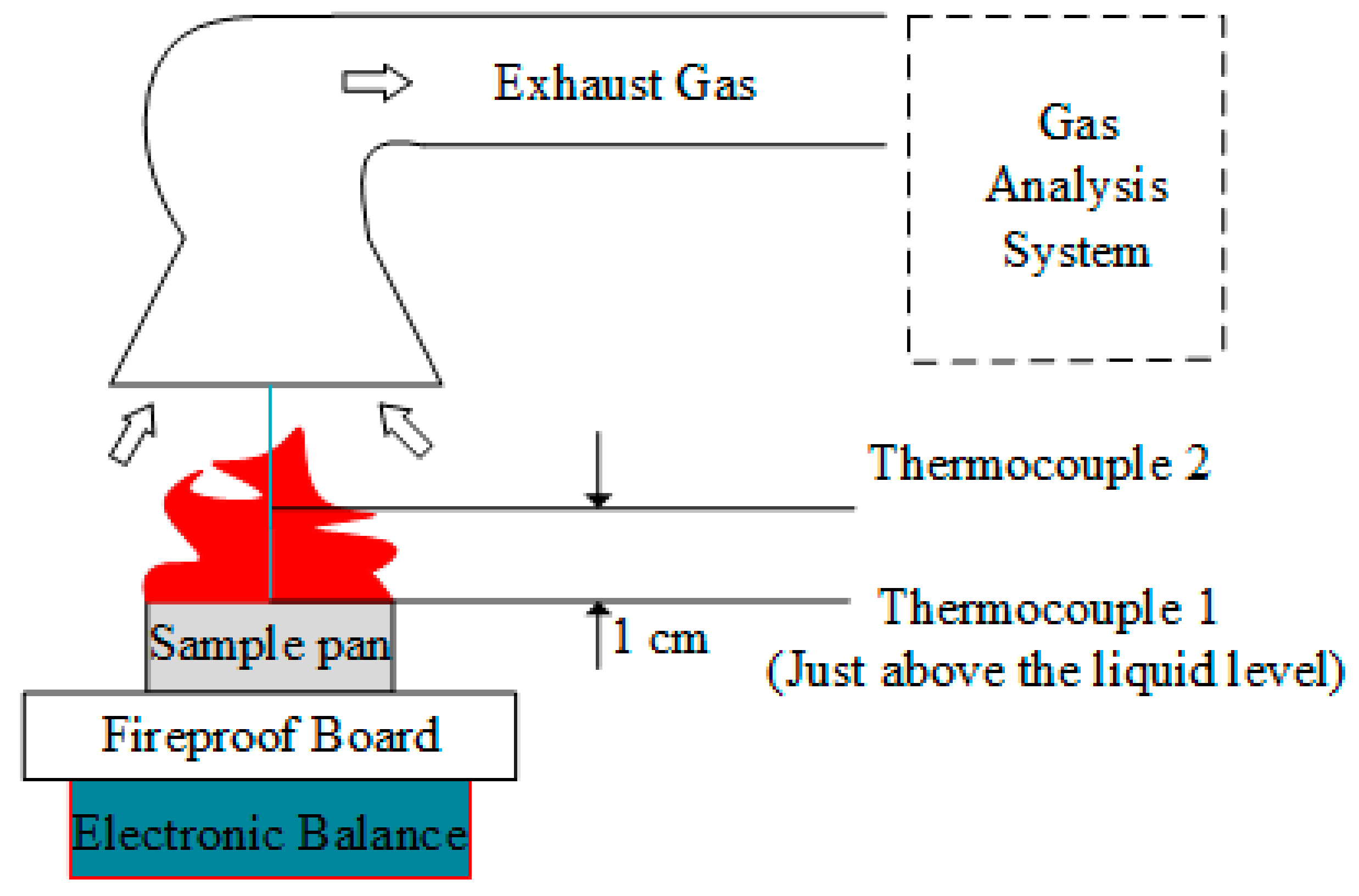

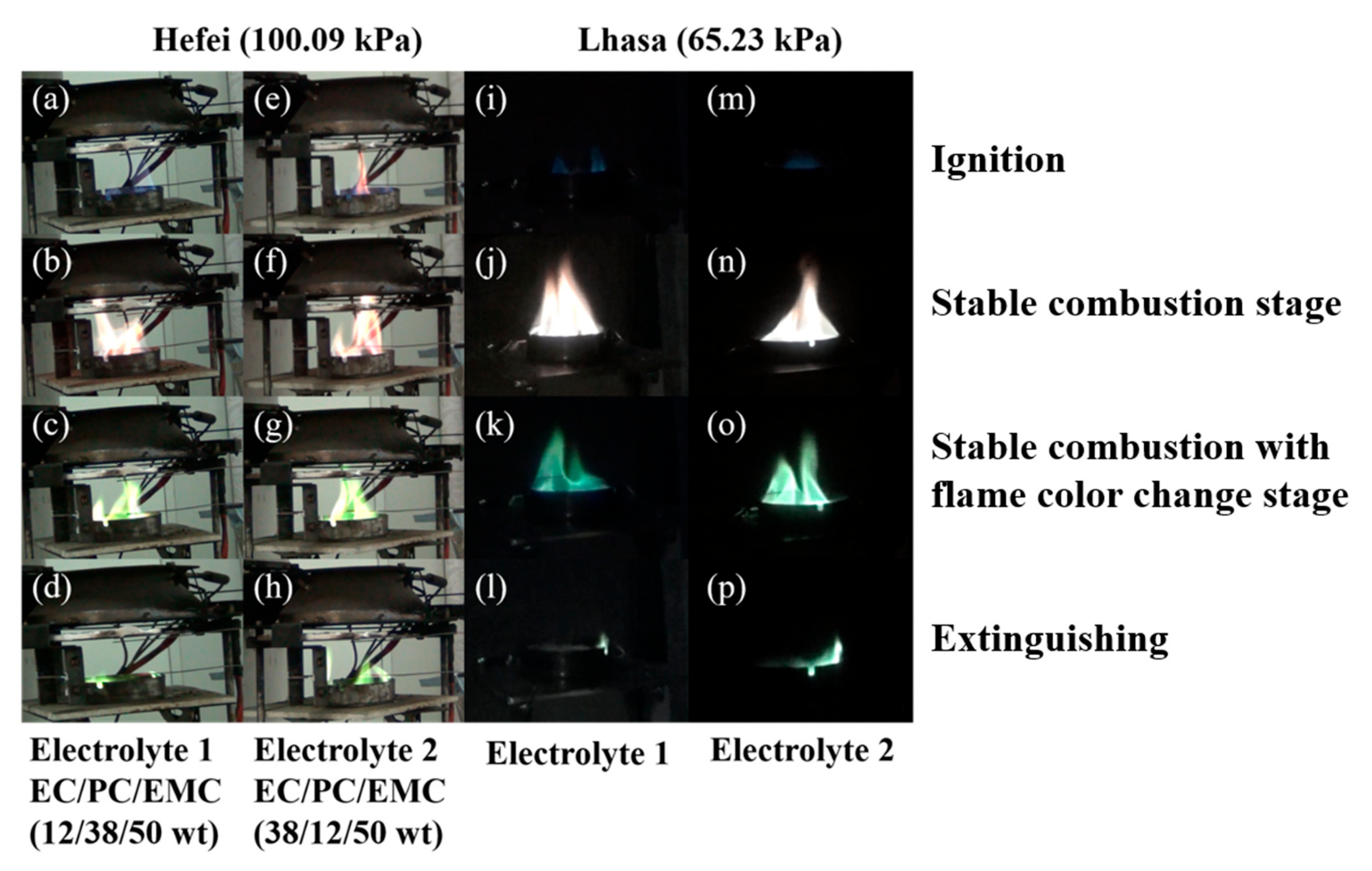
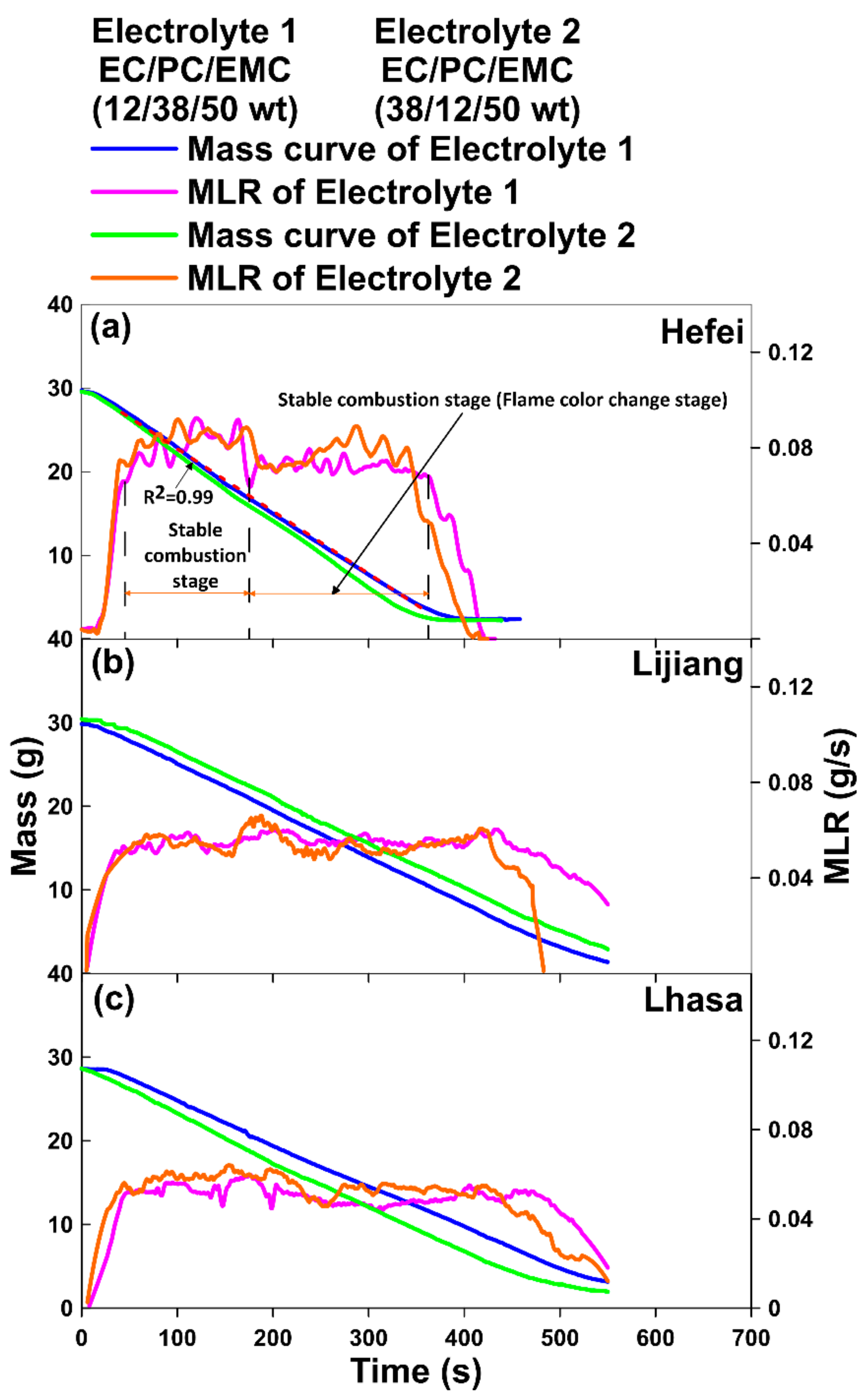
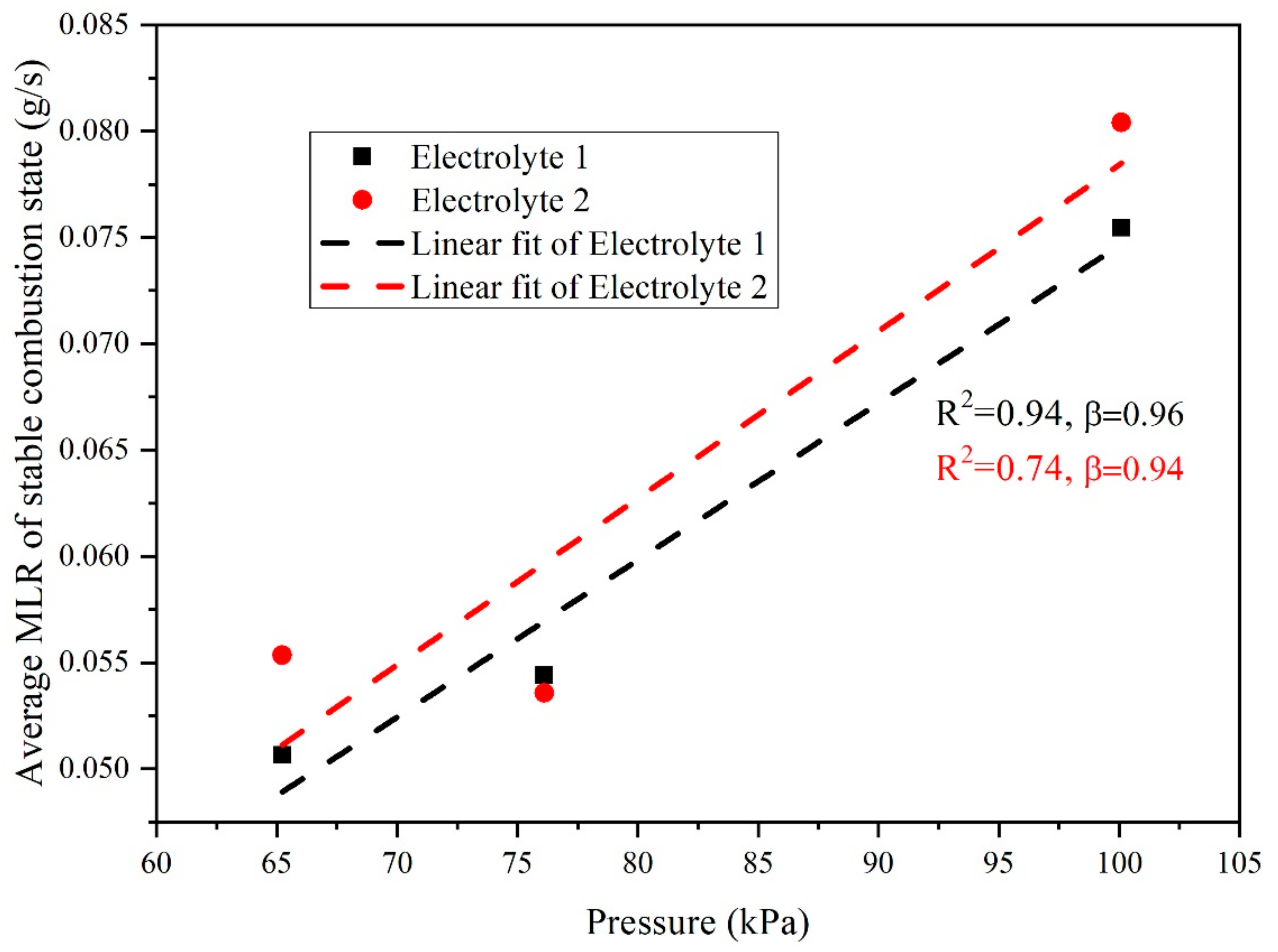


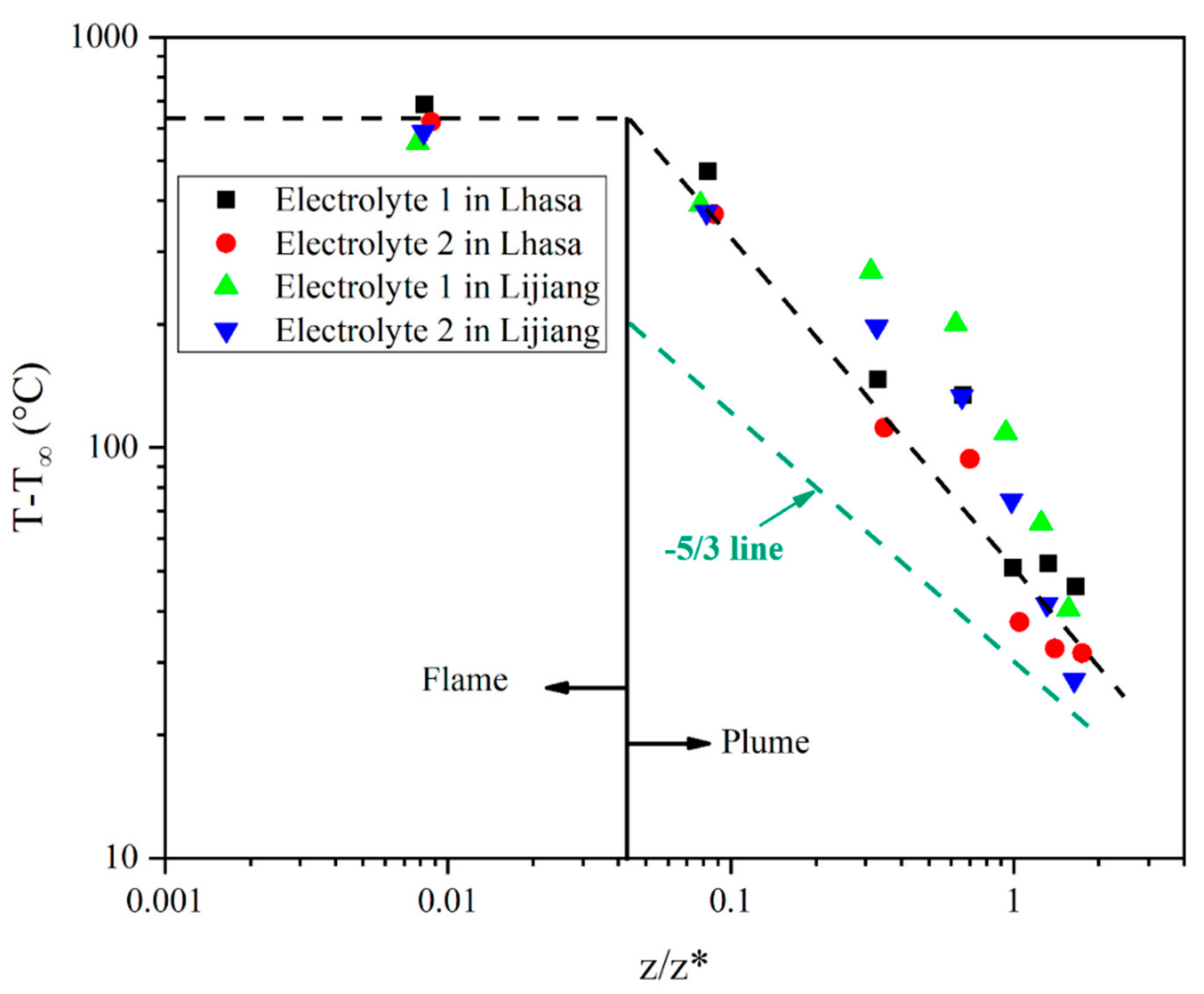

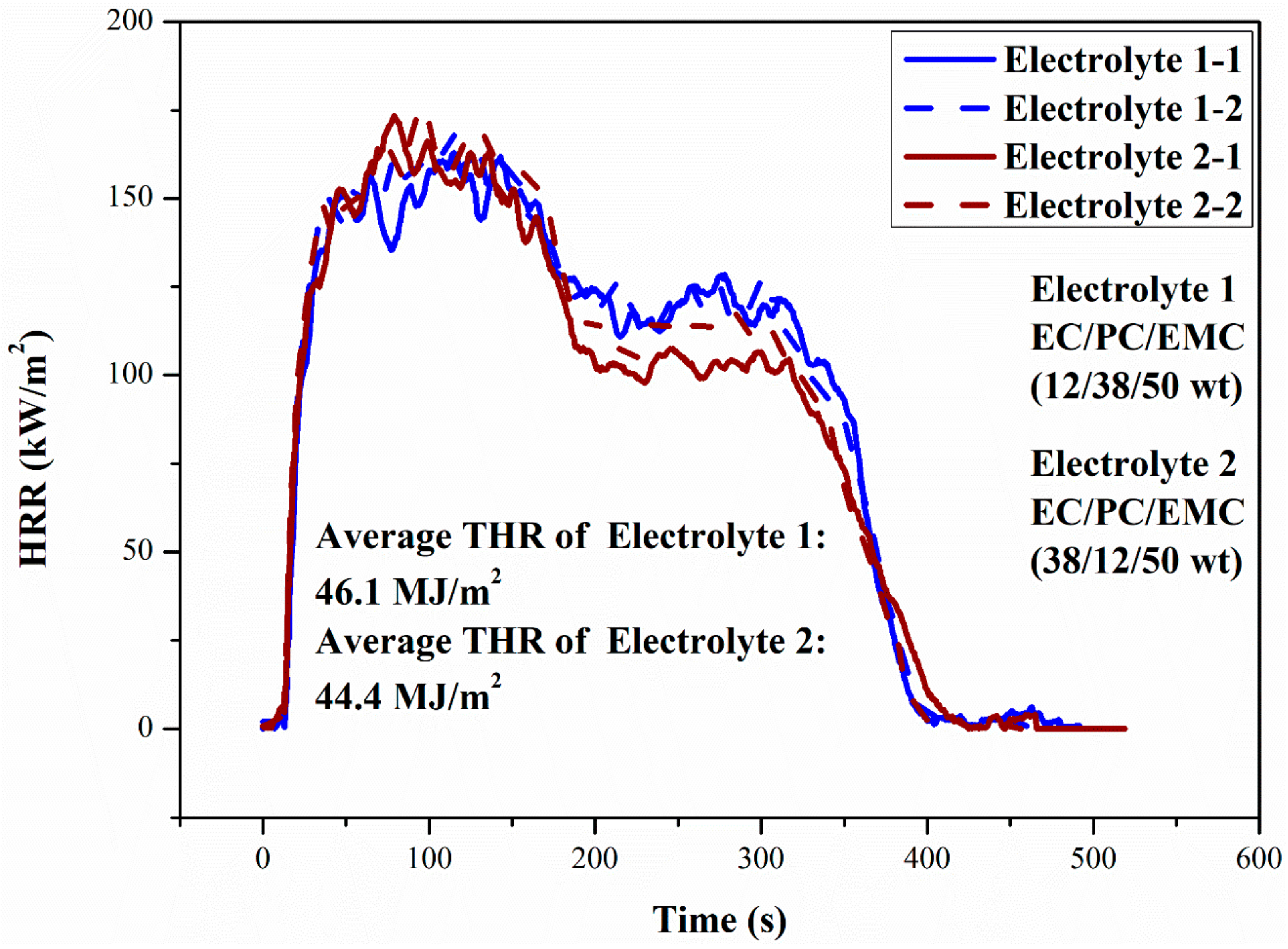
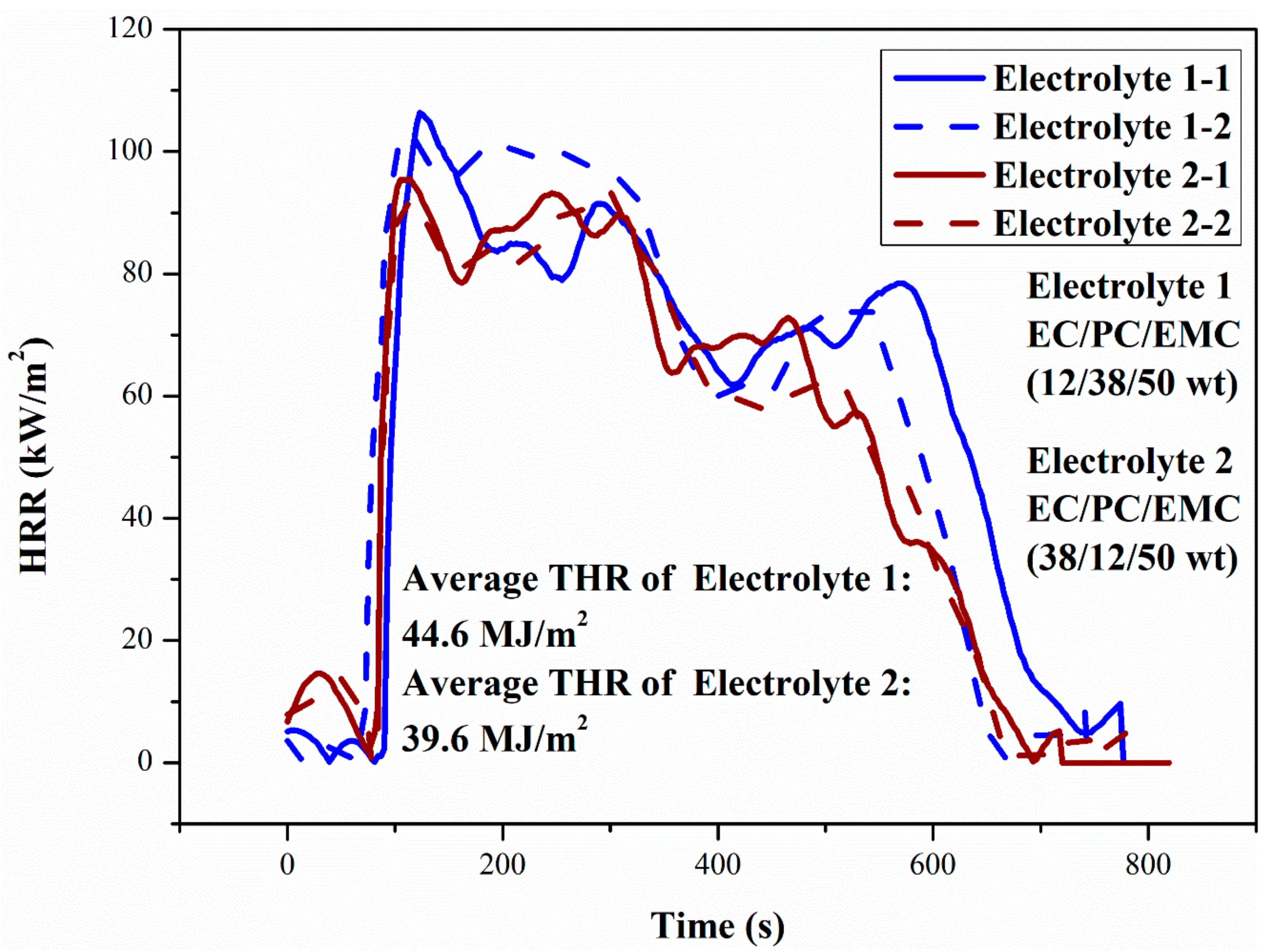
| Name | Chemical Formula | Melting Point (°C) | Flash Point (°C) | Boiling Point (°C) | Enthalpy of Formation (kJ/mol) | Enthalpy of Vaporization (kJ/g) | Heat of Combustion (kJ/g) | Autoignition Temperature (°C) | Driving Factor N | Chemical Structure |
|---|---|---|---|---|---|---|---|---|---|---|
| EC | C3H4O3 | 36 | 145 | 248 | 52.67 | 0.62 | 12.38 | 465 | 13 |  |
| PC | C4H6O3 | −48.8 | 128 | 242 | 56.27 | 0.55 | 16.56 | 455 | 20 |  |
| EMC | C4H8O3 | −14 | 23 | 110 | 39.16 | 0.34 | 18.41 | 440 | \ |  |
| Sample Number | Composition | Conductivity (25 °C, mS/cm) | Specific Gravity (20 °C, g/cm3) |
|---|---|---|---|
| Electrolyte 1 | 1 mol/L of LiBF4 dissolved in EC/PC/EMC with a mass ratio of 12:38:50 | 3.48 | 1.172 |
| Electrolyte 2 | 1 mol/L of LiBF4 dissolved in EC/PC/EMC with a mass ratio of 38:12:50 | 4.03 | 1.201 |
| Combustion Location | Burning Duration | |
|---|---|---|
| Electrolyte 1 EC/PC/EMC (12/38/50 wt) | Electrolyte 2 EC/PC/EMC (38/12/50 wt) | |
| Hefei (100.09 kPa) | 370 s | 377 s |
| Lijiang (76.11 kPa) | 617 s | 652 s |
| Lhasa (65.23 kPa) | 552 s | 562 s |
| Experimental Region | Average Temperature (°C) | |||
|---|---|---|---|---|
| Electrolyte 1 EC/PC/EMC (12/38/50 wt) | Electrolyte 2 EC/PC/EMC (38/12/50 wt) | |||
| Stable Combustion Stage | Stable Combustion with Flame Color Change Stage | Stable Combustion Stage | Stable Combustion with Flame Color Change Stage | |
| Hefei (100.09 kPa) | 524 | 405 | 527 | 395 |
| Lijiang (76.11 kPa) | 679 | 480 | 676 | 548 |
| Lhasa (65.23 kPa) | 786 | 693 | 730 | 555 |
| Q | Lijiang (76.11 kPa) | Lhasa (65.23 kPa) |
|---|---|---|
| Electrolyte 1 | 98 | 83 |
| Electrolyte 2 | 87 | 72 |
Publisher’s Note: MDPI stays neutral with regard to jurisdictional claims in published maps and institutional affiliations. |
© 2021 by the authors. Licensee MDPI, Basel, Switzerland. This article is an open access article distributed under the terms and conditions of the Creative Commons Attribution (CC BY) license (https://creativecommons.org/licenses/by/4.0/).
Share and Cite
Liu, C.; Zheng, K.; Zhou, Y.; Zhu, K.; Huang, Q. Experimental Thermal Hazard Investigation of Pressure and EC/PC/EMC Mass Ratio on Electrolyte. Energies 2021, 14, 2511. https://doi.org/10.3390/en14092511
Liu C, Zheng K, Zhou Y, Zhu K, Huang Q. Experimental Thermal Hazard Investigation of Pressure and EC/PC/EMC Mass Ratio on Electrolyte. Energies. 2021; 14(9):2511. https://doi.org/10.3390/en14092511
Chicago/Turabian StyleLiu, Changcheng, Kaihui Zheng, Yong Zhou, Kai Zhu, and Que Huang. 2021. "Experimental Thermal Hazard Investigation of Pressure and EC/PC/EMC Mass Ratio on Electrolyte" Energies 14, no. 9: 2511. https://doi.org/10.3390/en14092511
APA StyleLiu, C., Zheng, K., Zhou, Y., Zhu, K., & Huang, Q. (2021). Experimental Thermal Hazard Investigation of Pressure and EC/PC/EMC Mass Ratio on Electrolyte. Energies, 14(9), 2511. https://doi.org/10.3390/en14092511








